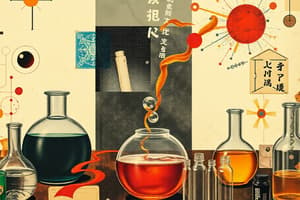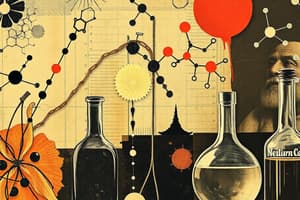Podcast
Questions and Answers
What happens to matter during the burning of a candle?
What happens to matter during the burning of a candle?
- Matter is destroyed when the candle burns.
- Matter remains unchanged throughout the burning.
- Matter changes forms during the burning process. (correct)
- Matter is created as the candle burns.
Which statement best describes ionic compounds?
Which statement best describes ionic compounds?
- They are formed from the sharing of valence electrons between nonmetals.
- They consist of positively and negatively charged ions attracted to each other. (correct)
- They are composed solely of metallic elements.
- They only exist as gases under standard conditions.
What defines a molecule in the context of covalent compounds?
What defines a molecule in the context of covalent compounds?
- A particle consisting of two or more atoms that share electrons. (correct)
- A single atom that has gained electrons.
- A substance that can only exist in a solid state.
- A collection of ions bound together by electrostatic forces.
Which of the following accurately represents the Law of Conservation of Energy?
Which of the following accurately represents the Law of Conservation of Energy?
How do covalent bonds generally form?
How do covalent bonds generally form?
Which type of energy is involved in the process of photosynthesis?
Which type of energy is involved in the process of photosynthesis?
What term describes a pure substance made of only one kind of atom?
What term describes a pure substance made of only one kind of atom?
Which of the following best describes a physical change?
Which of the following best describes a physical change?
What is the building block of matter?
What is the building block of matter?
Which form of energy is NOT listed in the types of energy?
Which form of energy is NOT listed in the types of energy?
What is the average kinetic energy of particles within a substance commonly referred to as?
What is the average kinetic energy of particles within a substance commonly referred to as?
Which of the following is a chemical change?
Which of the following is a chemical change?
Which of these is classified as mechanical energy?
Which of these is classified as mechanical energy?
Flashcards
Compound
Compound
A pure substance made from two or more elements that are chemically combined.
Bond
Bond
An electrostatic attraction that forms between atoms when they share or transfer electrons.
Law of Conservation of Matter
Law of Conservation of Matter
Matter cannot be created or destroyed, only change forms.
Law of Conservation of Energy
Law of Conservation of Energy
Signup and view all the flashcards
Molecule
Molecule
Signup and view all the flashcards
What is matter?
What is matter?
Signup and view all the flashcards
What's an atom?
What's an atom?
Signup and view all the flashcards
What's an element?
What's an element?
Signup and view all the flashcards
What is energy?
What is energy?
Signup and view all the flashcards
What's a physical change?
What's a physical change?
Signup and view all the flashcards
What's a chemical change?
What's a chemical change?
Signup and view all the flashcards
What's a compound?
What's a compound?
Signup and view all the flashcards
What's a molecule?
What's a molecule?
Signup and view all the flashcards
Study Notes
Chemistry of Living Things
- Living things are composed of matter
- Matter is anything that occupies space and has mass
- The fundamental building block of matter is an atom
- An element is a pure substance made of only one kind of atom
- Energy is the ability to do work; it powers biological processes
- Temperature measures average kinetic energy of particles in a substance
- What happens to living things without access to energy? They cease to function.
- Nonliving things also have energy
- What would the world be like without energy? It would be lifeless and inert.
- Examples of energy: mechanical, light, sound, electrical, thermal, chemical
Types of Energy
- Mechanical energy (kinetic and potential)
- Acoustic energy (sound)
- Light energy
- Thermal energy
- Electrical energy
- Chemical energy
Forms of Energy
- Light
- Thermal
- Electrical
- Mechanical
- Sound
- Chemical
Changes in Matter
- Physical change: the form or state of a substance changes, but the substance itself doesn't change
- Chemical change: a substance's identity changes
- Examples of physical change: boiling water, breaking a bone
- Examples of chemical change: baking a cake, photosynthesis, burning a candle
- Photosynthesis is a chemical change where plants use light energy to create sugars
- Burning a candle involves a chemical change where the candle's chemical composition transforms as it combines with oxygen
- Law of Conservation of Matter: matter cannot be created or destroyed, only change forms
- Law of Conservation of Energy: energy cannot be created or destroyed, only change forms
Conserving Matter
- Matter and energy are conserved in changes in matter and energy
- The "lost" or "gained" matter or energy can be tracked to see where it's going or coming from
Bond
- An electrostatic attraction that forms between atoms when they share or transfer electrons
Compound
- A pure substance made from two or more elements that are chemically combined
Ionic Compounds
- Atoms give or take valence electrons
- These ions attract to form compounds
- The bond typically forms between a metal and a nonmetal
Covalent Compounds
- Atoms share electrons
- A covalently bonded particle of two or more atoms is called a molecule
- The bond typically forms between two nonmetals.
Molecule of Water
- A water molecule forms when two hydrogen atoms share electrons with an oxygen atom
Studying That Suits You
Use AI to generate personalized quizzes and flashcards to suit your learning preferences.




